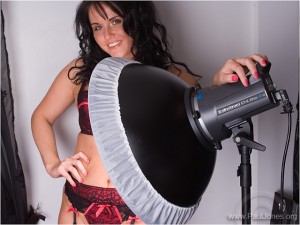With so many manufacturers and kits on the market it can be a daunting task trying to decide which studio lighting kit is best for your needs. In this post I’m going to talk about studio lighting kits and how I chose my current kit.
Some photographers like to use continuous lighting (hot lights). Some prefer the portability of using flashguns (speedlights) for a ‘strobist’ off camera flash approach. I have always felt most comfortable using studio flash units wherever possible.
A good resource for asking questions and finding out more about studio lighting is the ‘Studio and Lighting Techniques Forum’ at DPReview.com. I hang out there quite a bit and often see the same question from people – “which studio lighting kit should I buy?”
Over the years I have used various makes of lighting in studios, including Bowens, Broncolor and Elinchrom. I always had it in my head that my next studio lighting purchase would be a Bowens 500w/s kit – lots of flash power, solid metal construction, a reliable reputation, easy to use, lots of readily available lighting accessories and modifiers with the Bowens ‘S’ Fitting. Three of my professional photographer friends all used Bowens. Yes, no question… I was going to buy Bowens. But after months of research and pondering I went out and bought an Elinchrom kit.
In my research I studied websites, Youtube videos, review sites and spoke to several people. I considered studio lighting kits from the likes of Lencarta, Interfit, Coreflash, Calumet Genesis, Lastolite, etc, etc… It always kept coming back to a choice between Bowens or Elinchrom.
Once I had disregarded all other makes I then seriously had to decide which to buy. Would it be the Bowens 500w/s kit that I had always had as my number one, or would it be the Elinchrom BXRI 500w/s, or would it perhaps be the Bowens 400w/s kit, or the Elinchrom D-Lite IT 400w/s kit? Decisions, decisions…
Factors in my decision making process included:
Flash Power
The power of studio flash units is usually expressed in either Joules (J) or Watt Seconds (w/s). Both terms really mean the same thing. Studio flash units come in various powers, eg 200w/s, 300w/s, 400w/s, 500w/s, etc. In terms of flash power there isn’t such a great difference in output between a 400w/s unit and a 500w/s unit.
Some manufacturers also express the flash power by ‘Guide Number’ (GN) – the amount of light given out using a standard reflector dish at 100 ISO. As a general rule, the higher the w/s or GN numbers the more power you can get from the flash unit. But remember that in some circumstances having too much power can be as bad as not having enough.
Power Adjustment Range
Many flash units boast that they have a ‘5 Stop Range’. Much like dimming the lights in your home, flash power can be adjusted by turning a dial or by pressing a button, which means that the amount of power given out by the flash unit can cover, for example, from f/5.6, through f/8, f/11, f/16 upto f/22.
Some flash units just have a basic turn-dial, whereas some can give you the ability to alter the power in one-tenth of a stop increments, which makes for very precise exposures. For example, Elinchrom units have a digital readout where each press of the button on the back of the unit moves the exposure up or down by one-tenth of a stop.
Would I ever realistically need to shoot at anything beyond f/22? Given the locations that I tend to work in would a 500w/s kit really be needed? Could I justify the extra cost? In the end I talked myself out of the need for a 500w/s kit in favour of a 400w/s kit.
Flash Triggering
Once I had decided that I didn’t need a 500w/s kit this left me debating the Bowens 400w/s kit versus the Elinchrom 400w/s D-Lite IT kit. As they were both quite similar in price I looked at features.
The ‘traditional’ way to trigger a studio flash unit is to plug a sync lead from the unit into the camera. I don’t like trailing flash sync leads as they can lead to accidents or units being knocked over, so knew that I wanted to shoot wirelessly. A big selling point of the Elinchrom system is that it has ‘Skyport’ wireless triggering built into each flash unit, whereas I would have to buy a separate wireless triggering kit and plug it into the Bowens (such as the Bowens Pulsar wireless trigger kit). This got me more and more interested in Elinchrom.
Lighting Accessories
Another factor to consider is the availability of accessories or lighting modifiers to fit onto your studio flash kit.
Kits will often come bundled with an umbrella and a small softbox, or maybe two umbrellas, but you will want the option of being able to add more accessories.
Camera manufacturers like Nikon and Canon like to use ther own lens fittings and its the same with studio flash manufacturers. Try fitting a Bowens softbox onto an Elinchrom flash unit and you’ll have a problem. The two common fittings (certainly in the UK) are Bowens ‘S’ Fit and Elinchrom ‘EL’ fit. Having had a good look around the Internet I knew that finding modifiers from the manufacturers and from third-party suppliers wouldn’t be a problem.
Other Features
Some other factors to bear in mind when choosing your studio lighting kit include:
Fan Cooling – On a busy shoot the flash unit can get hot and it helps to have internal fan cooling built into the unit.
Recharging Time – After the flash unit has fired it needs to recharge itself ready for the next shot. With a budget unit this recharge can take a few seconds, which doesn’t sound a lot but it can be annoying if you’re in the flow of a shoot and you then have to wait before taking the next photograph. Units with a recycle time of around 0.5 seconds or less are easier to work with than ones that take 3-5 seconds.
Flash Ready Beep – Some flash units give out an audible beep to let you know that the unit is fully recharged and ready to fire. This can be helpful, but you can always turn the beep off if it gets on your nerves.
Portability – Will you be needing to carry the kit to different locations? How heavy is it? Will it all fit into an easy to carry bag?
Support – There may come a time when you need a spare part, eg a replacement flash tube, or the unit may need servicing. A factor to consider is how easy will it be to buy parts? Are parts readily available? Can you replace the parts yourself or will you have to send the unit away to have it fixed? Can you contact the manufacturer or their main dealer? How good is their support and after-sales care?
Personal Preference
With cameras some people just prefer to buy Canon, Nikon, Pentax, Fuji, etc. It’s the same with studio lighting kits. Bowens or Elinchrom? Lencarta or Interfit? Personal preference is bound to enter any buying decision.
Perhaps it’s human nature, but when I was shopping around I started to notice Elinchrom lighting being used in lots of photography videos by seasoned professional photographers. I chatted with a few more photographers online and found that they were also big fans of Elinchrom’s workmanship, Swiss engineering and reliability.
In the end I made my decision and bought the Elinchrom D-Lite IT 4 400w/s kit – complete with two Elinchrom D-Lite IT 400w/s flash units; two small softboxes; reflector dish; two lighting stands and Skyport wireless trigger kit. Thinking that the standard small softboxes wouldn’t be large enough for my needs I have also since added a larger softbox and a beauty dish, along with barn-doors, grid attachment and coloured gels. This has given me a kit that fits into a large carry-case and can easily be transported to location shoots.
So far, the Elinchrom D-Lite IT kit has been fantastic to use and has never let me down – easy to assemble and take down, fast recycle times means I never miss a shot or have to wait. The in-built Skyport wireless triggering is foolproof. Digital settings means that I can adjust power down to one-tenth of a stop, and there is more than enough power (5 stops from f/5.6 to f/22).
My only regret is that I didn’t buy it sooner.
Elinchrom have now superceded the D-Lite IT kit with their new D-Lite RX kits. See this link on Amazon for more information.
Here’s a shot of Michelle on a recent location shoot with my Elinchrom D-Lite IT. (The unit is sporting a beauty dish with ‘shower cap’ attachment)
Thanks for reading. I hope that it’s been useful. Feel free to comment.






outstanding review there Paul. You’ve pretty much summed up my thoughts. I have to say the sway would be the internal wireless reciever. I work with guys that use bowens and plugin recievers. Every single shoot there is an issue with either plugs, batteries, leads etc because it is a mobile studio setup and it gets a lot of wear and tear. The internal reciever should absolutely swing it for anyone
Thanks again
Keith
Thanks very much for your comment Keith. Much appreciated. I’m happy to report that after quite a bit of use the Elinchrom Skyport wireless triggering has never let me down.
Hi Paul! Thanks for this article. I am using two Elinchrom 200 Rxi lights.
I wana work on portraits in the studio & also shoot food. I am planning to invest in a 3rd light. Should I go for a 400 or stick to a 200?
I am told that the main lights should be more powerful than the 3rd light. In that case, I will have to get rid of my 200s & upgrade to the 400s. But I am not making a lot of money out of this, so upgrading now seems difficult.
Should I go for a 200 or 400 as my 3rd? I’m confused.
Thanks for your time.
Prateek Sharma.
http://www.weddingphotodiary.com
Hi Prateek and thanks for commenting.
It’s personal choice, but I think if I could afford the 400 I would get that as it will give you a bit more flexibility, for example an extra aperture stop if needed.
Whilst there are no rules set in stone with photography, what you may have been told is that many photographers like to set their fill light/s to between one and two stops less power than the main light to give more pleasing, and less flat, lighting.
Depending upon your style of photography and the aperture you prefer to shoot at, I don’t think there is much need to upgrade all your lights just now. A kit with two 200w/s lights and one 400 w/s light should be good enough for now.
Practise with what you have.
Best regards
Paul
Thanks, Thanks & Thanks….. You made my life easy…..
I am exactly at same situation as yours and not sure where to put my money 🙂
Please do advise if you have any experience/suggestion you can share as you are using it for a year now I assume.
Thank-you for your comment Vinay.
Yes, I’m still happy with Elinchrom and have no complaints. Invest in a decent lighting kit from a trusted brand and you should hopefully have no problems.
Many thanks
Paul
Thanks to your great advice Paul, I am now the proud owner of an Elinchrom D-Lite 4X studio lighting set, and I look forward to my first session with it. Thanks once again, I’m always grateful for your advice and help.
Thanks for your comment Mel. 🙂
Very helpful review which I found via dpreview.com whilst researching Elinchrom D-Lites. Thanks Paul.
Thanks for taking time to comment, Alastair!
hi paul,im looking at getting some studio lighting for mobile shoots mostly in clients homes,can i use only one light with a large say 5ft umbrella,or do i need ore than on light,i was looking at the elinchrom d lite 4 rx,would this be to powerfull in a small enviroment
Hi David and thanks for commenting.
One light is actually a good way to start. It’s a good way to get into the habit of ‘seeing’ the light, where it’s illuminating and where it’s causing shadows. You can build up your skills and kit to a second, third, etc light afterwards. I started with one light, but now tend to use two or three most of the time.
Personally, I don’t think the Elinchrom would be ‘too powerful’. With a brolly on and depending on what power setting you use and the distance of the light from the subject I think you would be looking at using a range of apertures from around f5.6 to f/11.
If you want to add other modifiers such as a beauty dish, softbox, etc, have a look at the range of modifiers on Bessel.co.uk – I have several of their items.
I hope that’s helpful.
Hi Paul
I have bought Elinchrom Dlite 400, 2 heads. I only shoot in a very small room, often on fstop 2.8. I keep getting over exposed images. As I’m only learning, I was told that my lights are too strong. Should I invest into Dlite One, would that make any difference? Also, I was thinking about buying umbrella Octobox 120cm, would it help to soften up my current lights?
Thank you for your help.
Mira
Hello Mira and thanks for posting.
Without knowing your circumstances better, I would say in general NO, the lights are not too powerful. You just need to familiarise yourself with how to use them. It’s a matter of learning how to set the correct exposure on your subject so that the images are not over exposed. If you have a lightmeter / flashmeter this would help, but if not you can use trial and error and check the histogram on the back of the camera.
As a starting point, set your camera to Manual mode; set the ISO to its lowest (eg 100 ISO, 200 ISO); set the shutter speed to the camera’s recommended flash sync speed (eg 1/125, 1/160, 1/200); set the aperture to f/8.
Now set your lights to their lowest power setting, take a photo and check the exposure on the back of the camera using the histogram / preview. Is it too dark, too light, etc? If too dark and under exposed you can adjust the aperture or ISO, for example you might open up the aperture by one stop to f/5.6. If too bright and over exposed you might adjust the aperture by one stop to f/11.
When you are familiar with the lights you will get an idea of what power setting will give you what exposure at what distance. The lights have a 5 stop exposure range.
Adding a modifier onto the light, such as a softbox or octobox will soften the light and also reduce the power output by around one stop. As a general rule, the closer the light is with a softbox on, the softer the effect.
I hope this has been helpful. I think most people experience these kind of questions when they start using studio lighting, but it’s a matter of practice makes perfect.
Good luck with your photography.
Paul
New to studio photography is the D. lite 4 to go easy to use for someone that is just starting out as i want to do portrait work also how much is the set new
Hi Frank
Thanks for leaving a comment.
Yes, I found the Elinchrom lights very easy to use and have had no problems using them at all.
Elinchrom have now replaced / upgraded the DLite 4 to a newer model, DLite RX4. A 2 head kit is about £750 on Amazon – http://www.amazon.co.uk/dp/B01CJWWWIY/?tag=paujon-21 – or http://www.theflashcentre.com
Cheers
Paul
Hi Paul,
Those are some really great images you have here. Nice work.
I also found your review through DPReview and is much appreciated.
I’m looking into buying a D-Lite RX 2 for my first Photo Booth I’m going to build and have some questions you might be able to help me with:
– (as I’m really new to this kind of lights) are they continuous lights or strobes? I’ve seen a video of an exhibition where the light was constantly on, but on a website, it says the bulb will last 10.000 exposures. Or will it do both?
– What is your experience with the bulb? How long do they actually last in practice? Or is that difficult to say for you, as you have the 400 watts ones?
– As I understand their power can be turned down. As I don’t know how much business with the booth there will be in the beginning, could I buy a 400 watts one and turn down the power for the booth, and use it as a studio light, too?
Thanks in advance for you time and sharing your experience.
Cheers,
Mike.
Hi Mike and thank you very much for your comments.
The Elinchrom D-Lites are studio flash (strobes). Not continuous lights.
The D-Lites, like most studio strobes, have a ‘modelling light’ which can be left on to show where the light is hitting the subject. When the flash fires it is so fast that the modelling light doesn’t affect it. Note that you can choose to turn the modelling light off if you want to.
Studio flash bulbs tend to have very long lives. I’ve been using the original bulbs since 2013 with no problems at all. The D-Lites are still going strong and have been a good investment. I can’t say how many times I’ve fired them but it must be quite a few thousand.
Yes, you can certainly turn the power down on the D-Lites and almost all other studio flash units. My D-Lites have a 5 stop power range, meaning in effect that you could shoot with apertures ranging from f/5.6 up to f/22.
I hope that helps.
Paul